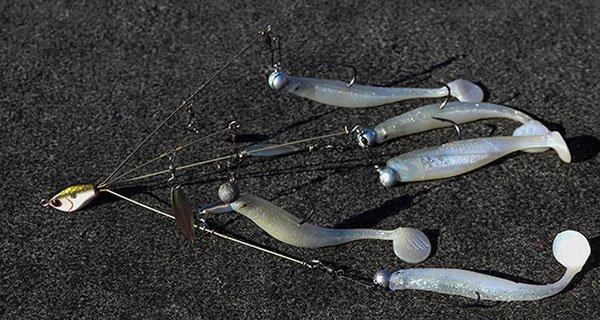Like any good technique, lure or rig, anglers have to continually adapt to the conditions, the pressure and the mood of the bass. The Alabama Rig and all the bass umbrella rigs that came after caught bass easily and often when they first hit the market. But now it’s becoming more like any other rig. You’ve got to fish umbrella rigs in the right conditions and tailor them to the environment and bass. Here are 7 tips on how to fish for bass with castable umbrella rigs. Most of these tips, moreover, apply to a single swimbait fishing.
1. Experiment with bait size and shape
In 2012 when the Alabama Rig hit the scene, I honestly think you could put five of anything on an there and catch the heck out of bass for the first couple of months. But now the baits you choose really seem to matter. Fishing recently with some good umbrella rig anglers, there were definitely smaller baits that produced well on certain days and colors of water. And there were also times where one big bait in the middle with 4 little ones around it caught bigger fish
Five big swimbaits still catches fish, but it seems like the bites are a lot less compared to last year. I actually keep a Plano box of 4 complete rigs all with different baits so I can mix it up constantly. One might have 5 grubs. One holds 5 hollow bodied swimbaits and one I lace with 5 shad tails to keep experimenting with profile and color
2. Spin the bass out
Like with any other rig or lure, multiple variations of umbrella rigs exist, but one variation, umbrella rigs with willow leaf blades, produces especially well. Deep, cold-water bass seem especially susceptible to spinners. When you’re catching bass 20-30 feet deep, a spinner can help slow the rig down and help lock the bass on its target.
3. Fish deeper
When the water was a lot warmer just running the bays and flats and chunking and winding umbrella rigs worked well. But as the water quickly got colder, bass dropped off the side of channel breaks and stayed deep with the massive schools of shad trying to insulate against the freezing temperatures. For this reason an angler needs to get off the bank and focus more on the bottom of drops and deep flats.
4. Let it fall
Folks assume you have to emulate trolling when fishing a castable umbrella rig. But truth be told, letting the rig pendulum down a drop is highly effective. I’ve seen and taken several bass this winter letting the rig pendulum down a deep break and before it gets into the school, a fight has already ensued.
5. It’s okay to have a stutter
The stutter step with a crankbait, a spinnerbait and even a topwater can prove deadly. Guess what? It works well with umbrella rigs too. Try to envision what the bass sees when you fish an umbrella rig. Five little shad go easing by, so he decides to follow it slowly behind. Not sure if he really wants to run it down. Then for no reason all the shad just sort of stop and collide and act frantic for a split second, then take off again. It’s the trigger that fish needed to push him over the top.
6. Fish it near cover
There is at least $30 tied up in one umbrella rig in most cases, and losing one nauseates most anglers. But that also means bass around cover aren’t going to see as many. This is a little harder to master. But you need good lineups on your dead grass edges, brush piles, stumps, etc. You want to be able to run over or next to without being stuck. I’ve taken and seen some mighty big bass recently in deep water near large stumps and brush piles. It’s worth the extra effort for a really big bass
7. Slow your roll
When the water is warm and the bass are schooled and competitive and willing to chase, winding the rig in at a good clip will produce some bites. But in cold water those bass are waiting for something to just creep in and out of their zone. Shad aren’t in any big hurry this time of year. You want to wind it just fast enough to keep it off the bottom and the blades turning and the tails kicking. Much faster than that and you’re drastically reducing your bites in the winter.
In late winter and early spring, I will put the rigs away, and they won’t see the light of day until the next fall. But I’ve had a ball fishing with FLW Tour anglers Charlie Evans and Terry Bolton and FLW Tour Director Bill Taylor for big Kentucky Lake bass the last couple of years in the winter. Guys have been catching big strings still on the umbrella rigs in the winter, but the approaches and lures have become a lot more refined just like with any bass fishing technique.
The Alabama Rig probably won’t ever see that perfect storm it saw in 2011, but it and the other umbrella rigs are still tools for certain situations around the fall and winter months for some fun big bass catching.
When the buzzbait first hit the market, it didn’t matter what size or color you chose, it caught the fire out of the bass. But then it became just another tool to catch bass under certain conditions. It helps me to keep an open mind and always be thinking about giving the bass a new look.












